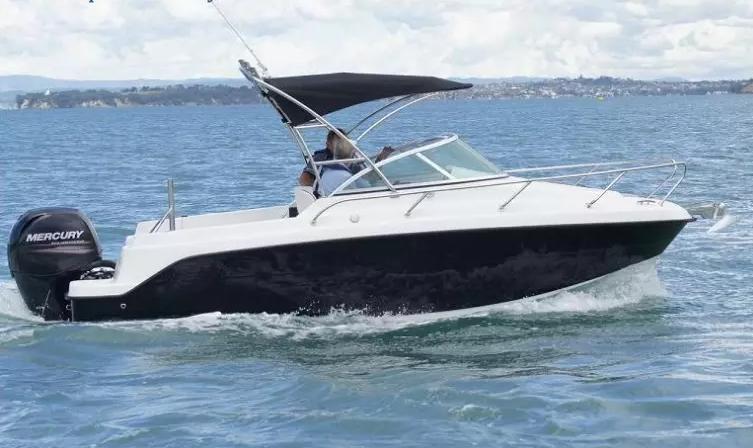Most metals on the market are not marketed as single-element objects. To obtain material properties, metals are alloyed with other elements; the characteristics of these alloys are referred to as their grades. A manufacturer selects a grade according to the final application of the product.

What is marine grade aluminium?
There are numerous grades of aluminium commercially available. Due to the elements that are alloyed with the aluminium, marine-grade aluminium alloys can withstand exposure to sunlight and water. Magnesium and silicon are the key elements added to alloys to make them marine-grade. Some marine grades are more resistant to salt water, which increases the metal's chemical stress.
Marine-grade aluminium is used for boats, but it can also be found on docks, railings, ladders, and stairs, as well as other furnishings and objects typically used on or near the sea. Marine-grade aluminium can also be used in tanks and storage facilities; their application is not limited to marine environments.
Although aluminium is often utilised for floatable watercraft, it is rarely utilised for submarines. Diving's compression forces wreak havoc on aluminium, leading to eventual wear and fracture. In addition, constant exposure to sea water without oxygen accelerates corrosion.

What type of aluminium is used in boat construction?
Choosing the appropriate grade of aluminium requires balancing cost, production simplicity, and material qualities. Some alloys are simpler to shape or weld, which are crucial production issues in hull construction. The corrosion resistance of other alloys may be superior.
The majority of retail aluminium boats are constructed from 5052. This grade of wrought aluminium comprises 2.2% to 2.8% magnesium and 0.15 to 0.35 percent chromium, which contribute to its corrosion resistance. However, the workability is just fair, thus different alloys may be used for some components of the boat.
The 6061 aluminium alloy for construction has superior corrosion resistance and is easier to work, weld, and finish than the 5052. This aluminium is frequently used to provide additional strength or to create components that would be impossible to create with 5052. 6061 is more expensive and is thus utilised only when the material's characteristics and workability justify the additional expense.
85% of aluminium is sold as wrought aluminium, although cast aluminium is often utilised for components that require near-net forms straight from the mould. A356, which is nearly similar to 6061, is the most common marine casting grade. Silicon in 6061 enables cast aluminium to capture mould features.
A graphic depiction of the galvanic scale ranging from passive gold to active beryllium
Brass, bronze, or copper should not be used to adorn aluminium vessels and other marine things.
Galvanic corrosion in aluminium
Typically, marine vessels are ornamented with brass, bronze, or copper. Due to its renown corrosion resistance, stainless steel is frequently used in marine conditions.
These metals should be avoided in aluminium boat attachments. They are capable of causing galvanic corrosion. When two metals that are widely apart on the galvanic scale come into contact with electrolytes, galvanic corrosion occurs. The anodic or active element provides ions to the cathodic or passive metal, which eventually erodes the anode. Aluminum is one of the more active metals and will give up many ions to copper and stainless steel at a slower but consistent rate.
Aluminum is so reactive that it is occasionally employed as a "sacrificial anode." A chunk of aluminium will either be connected to the hull of a steel ship or thrown overboard in a nett. The corrosion of aluminium protects the steel.
Galvanic corrosion is another reason aluminium is not used to construct submarines. Many of the components required to operate a submarine, such as the nuclear reactor, must be built from different metals that, when in touch with the aluminium hull, could accelerate corrosion.
Painting (with epoxy paint) below the waterline is one method for reducing the risk of galvanic corrosion, particularly when anchored near steel-hulled boats or submerged steel components.
Why would you use metal near water?
Aluminum is commonly used for boats, docks, pontoons, site furniture, and ladders due to its light weight and high strength. When raw metal is exposed to air and water (as opposed to being submerged constantly), the aluminium oxide that forms on the surface can guard against further corrosion. Standard grades of aluminium in the 3000 range are susceptible to rapid oxidation in marine environments. If you're purchasing aluminium for use in or near water, be sure to use marine-grade material, such as 5000 series or 6000 series builder's aluminium. With proper care and maintenance, these grades give aluminium objects near water a long service life.
Most of our quotes are delivered within 24/36 hrs. and usually in much less time, depending on project details.
Our team will contact you directly about your CNC machining quote to ensure you’ve received and understand all aspects of your quotation and to answer any questions you may have about your options.